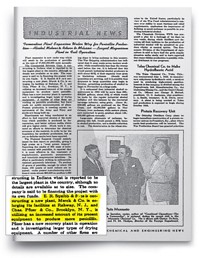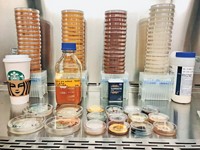Advertisement
Grab your lab coat. Let's get started
Welcome!
Welcome!
Create an account below to get 6 C&EN articles per month, receive newsletters and more - all free.
It seems this is your first time logging in online. Please enter the following information to continue.
As an ACS member you automatically get access to this site. All we need is few more details to create your reading experience.
Not you? Sign in with a different account.
Not you? Sign in with a different account.
ERROR 1
ERROR 1
ERROR 2
ERROR 2
ERROR 2
ERROR 2
ERROR 2
Password and Confirm password must match.
If you have an ACS member number, please enter it here so we can link this account to your membership. (optional)
ERROR 2
ACS values your privacy. By submitting your information, you are gaining access to C&EN and subscribing to our weekly newsletter. We use the information you provide to make your reading experience better, and we will never sell your data to third party members.
Synthesis
From C&EN Archives: Antibiotics
by Michael Torrice
September 9, 2013
| A version of this story appeared in
Volume 91, Issue 36
COVER STORY
From C&EN Archives: Antibiotics
The Antibiotic Age After his work on the discovery of streptomycin—research that garnered him the Nobel Prize in 1952—Selman A. Waksman became a popular speaker across the country. A 1950 story summarizes a talk given by Waksman at a scientific meeting in Detroit (C&EN, Oct. 30, 1950, page 3774). Reflecting on the great number of new antibacterial agents discovered and developed in the 1940s, he referred to the decade as the “antibiotic age.” He was so excited about the successes that he “held out hope for the eventual control of all infectious diseases through development and use of more and better antibiotics.”
Flower Bed Antibiotic During the early days of antibacterial discovery, drugs moved from the laboratory to the clinic much faster than they do today. According to a 1958 story, kanamycin, a member of the aminoglycoside class, reached market in about a year (C&EN, July 28, 1958, page 24). Scientists discovered the compound in a microbe living in soil outside Nagoya University in Japan: “Out of a Japanese flower bed has emerged mankind’s newest weapon against disease.”
Mobilizing Penicillin In 1943, pharmaceutical companies were producing as much penicillin as they could to send to the front lines of World War II. A story from scientists at Pfizer explains the history of the “miracle drug,” their efforts to make it on a large scale, and the effects of treatment on patients (C&EN, Sept. 10, 1943, page 1429). The article contains photographs showing the scale of the operations, such as a room filled with fermentation flasks containing the penicillin-producing fungus.
MORE ON THIS STORY
Introduction: Nine For Ninety | PDF
Chemical Connections | PDF
Antibacterial Boom And Bust | PDF
Small Science, Big Future | PDF
Understanding The Workings Of Life | PDF
Chemistry By The Numbers | PDF
Plastic Planet | PDF
The Catalysis Chronicles | PDF
Giving Chemists A Helping Hand | PDF
It's Not Easy Being Green | PDF
Readers' Favorite Stories | PDF
Nine Decades Of The Central Science | PDF
How Chemistry Changed the World | C&EN's 90th Anniversary Poster Timeline
Trying To Explain A Bond
A Toast To C&EN At 90




Join the conversation
Contact the reporter
Submit a Letter to the Editor for publication
Engage with us on Twitter